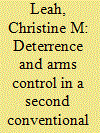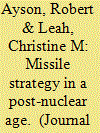| Srl | Item |
| 1 |
ID:
142786


|
|
|
|
|
| Summary/Abstract |
Neither further nuclear reductions nor total nuclear disarmament are necessarily smart ideas, but proponents of these goals insist that we should move toward a second conventional age, in which nuclear weapons are either marginalized or completely removed from international politics. But in this world, deterrence and extended deterrence might not endure without boosting aspects of conventional arsenals. How might the U.S. deter adversaries and assure allies? The answer ultimately rests on conventional forces, especially long-range ballistic and cruise missiles. But these would have to be deployed in greater numbers to compensate for a “nuclear gap.” This might lead to a destabilizing arms race.
|
|
|
|
|
|
|
|
|
|
|
|
|
|
|
|
| 2 |
ID:
137243


|
|
|
|
|
| Summary/Abstract |
While the arrival of nuclear weapons coincided roughly with the development of short, medium, intermediate, and eventually intercontinental missiles, the contribution of missile technology to the deterrence equation is often lost. If nuclear weapons were eliminated, even new generation missiles with conventional payloads could struggle to render effective deterrence. But some of the physical and psychological effects commonly ascribed to nuclear weapons could still be in play. And in a world without nuclear weapons, thinking about the use and control of force from the nuclear age would also deserve renewed attention.
|
|
|
|
|
|
|
|
|
|
|
|
|
|
|
|
| 3 |
ID:
114745


|
|
|
|
|
| Publication |
2012.
|
| Summary/Abstract |
This article addresses the question of how US extended nuclear deterrence might endure in a shifting Asia-Pacific where the traditional nuclear order underpinning the credibility of US security guarantees is deteriorating. The Australian case study demonstrates how periods of nuclear order and disorder can inform a state's attitudes toward the credibility of extended nuclear deterrence. Australia's interest in a nuclear weapons capability from 1956 to 1972 was symptomatic of a period of nuclear disorder. This interest declined from the early 1970s due to changes in both the global and regional environments where the proliferation and use of nuclear weapons was relatively contained. This emerging, recognizable nuclear order diminished the interest in an indigenous nuclear weapons capability and led Canberra to rely on US extended nuclear deterrence. This order has remained fairly robust for more than 30 years. However, beyond 2012, we may yet witness a breakdown in this order. This will generate a much greater interest by US allies in the operational aspects of US extended nuclear deterrence.
|
|
|
|
|
|
|
|
|
|
|
|
|
|
|
|